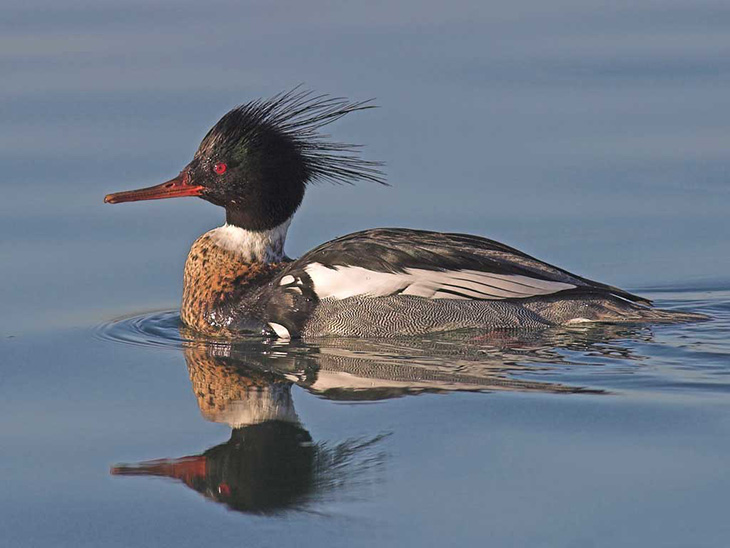Red-breasted Merganser (Mergus serrator) can have a dark green head with a “double crest”, white collar, dark brown chest, and white wing patches. It can also be gray with a pale brown head and white belly.
Flocks of fast-flying ducks with long necks, slender beaks, and white wing patches could be this species. Watch for Red-breasted Mergansers on large lakes and near beaches!
Have you ever wondered what mergansers do? Learn all about this neat bird in this article!
On this page
Identification
The male Red-breasted Merganser is a big and slender duck with a white collar, mottled brown and black chest, and a few white markings on its upper flanks.
It has red eyes, a wispy, “double crest” on its glossy, dark green head, and a long, narrow, orange, slightly upturned beak.
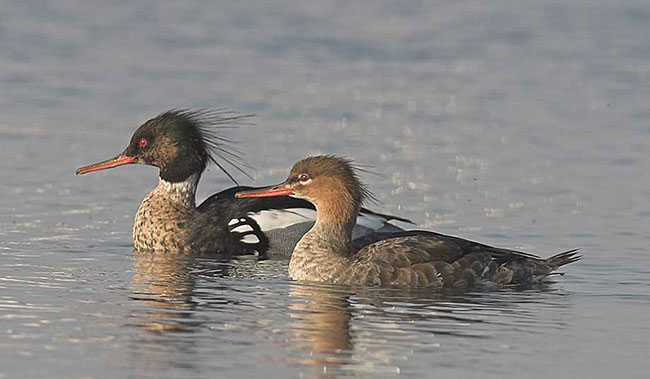
Female Red-breasted Mergansers have more laid-back plumage
Male Red-breasted Mergansers also have a white belly, gray flanks, and a rounded gray tail.
Females are shaped like male birds but look very different. They have a pale brown neck and head with a bit of white near their eyes, gray on their upperparts, chest, and flanks, and a white belly.
Non-breeding males and young birds resemble females.
In flight, all Red-breasted Mergansers show white on half of their underwing and a prominent white patch on the base of their upperwing.
Related: 12 Facts About Ducks
These big ducks are nearly two feet long, have a 30-inch wingspan, and weigh 2.3 pounds. In summer, they are usually seen in pairs, but in migration and winter, they can occur in big flocks. We often see groups of red-breasted Mergansers diving or moving along in fast, direct flight just over the waves.
They are usually quiet but sometimes make nasal, raspy calls, “ryeah reh reh”.
Food
Red-breasted Mergansers feed on small fish and some small aquatic creatures. They are very much adapted to catching fish underwater and eat a wide variety of species.
In some places, these big ducks are important predators of young Atlantic Salmon. However, the fish species they catch the most are minnows, Killifish, shiners, and other similar species.
Shrimp and small crayfish can make up a quarter of their diet, but Red-breasted Mergansers definitely prefer to eat fish.
As expected for their diet, Red-breasted Mergansers like to forage in shallow waters where minnows and other small fish are most common. In very shallow water, they can snatch fish with their beaks as they float on the surface.
However, in deeper water (up to 30 feet deep), these ducks dive and catch prey underwater. They like to submerge and use their webbed feet to propel themselves as they chase their prey.
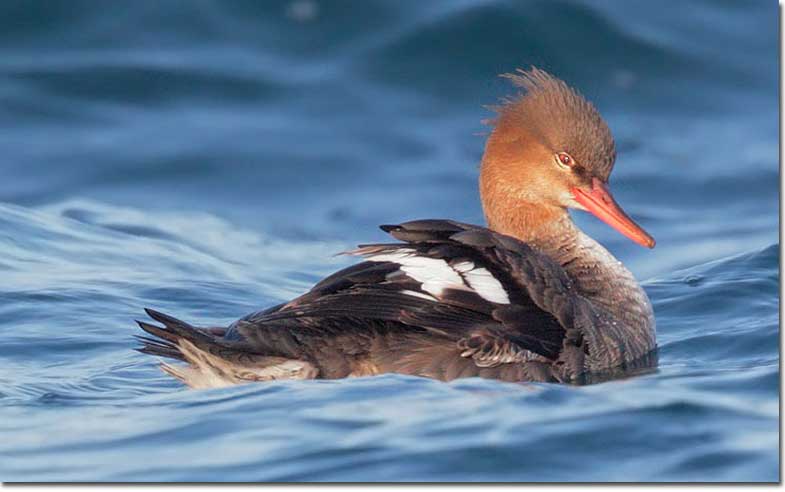
They use their beaks to quickly snap at small fish and then rise to the surface to eat it.
Instead of staying underwater for very long, Red-breasted Mergansers make quick, repeated dives. They can also forage in flocks that go after schooling fish, and use their beaks to probe crevices or other spots where prey might be hiding.
Nesting and Eggs
Red-breasted Mergansers nest later than many other ducks, usually between April and June. After arriving on their breeding grounds, the female searches for a suitable nesting site.
She looks for a spot on the ground with some dense cover, not more than 60 feet from the edge of a river or other body of water.
Good nesting spots can be under a log, low branches, in dense grass, or in debris that hide the nest and hen duck. In some places where they nest in dense grass, female mergansers make tunnels through the grass to reach the nest.
They can nest alone, or in colonies, sometimes with gulls and terns.
To make her nest, the mother duck creates a shallow depression and lays anywhere from 3-24 olive-buff eggs. During and after egg laying, she lines her nest with feathers and grass.
The eggs are 2.5 inches long, weigh 2.39 ounces, and hatch after 28-35 days. Within 24 hours, the merganser ducklings leave the nest and are led to water by their mother. They can feed on their own, but for the next 5 or so weeks, she brings them to good feeding area.
The mother duck also tries to protect them from predators, and helps keep them warm on cold nights.
Current Situation
The Red-breasted Merganser is a common bird that breeds in a large area of Alaska, Canada, parts of the northern USA, and northern Eurasia. In North America, flocks winter in coastal waters and on large lakes from Alaska and eastern Canada to Mexico.
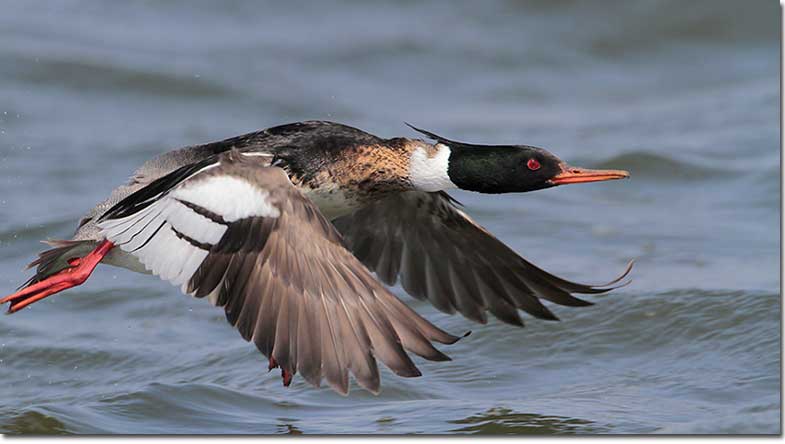
This species is listed as Least Concern in the IUCN Red List and is common and easy to see in most parts of their range.
Red-breasted Mergansers have a stable and large, global estimated population of 500,000 to 600,000 birds.
This species could be locally affected by habitat degradation and, in some areas, is susceptible to being caught in fishing nets.
However, compared to many other birds, they seem to be doing very well and are not considered threatened in any parts of their range. In winter, large numbers are easily seen in the Great Lakes area and in many coastal regions.
Facts
- In the past, other names that have been used for the Red-breasted Merganser. On account of its fish-eating habits and slender shape, it has been known as the “Fish Duck”. In Britain, it has also been referred to as the “Red-breasted Sheldrake”. This name refers to its resemblance to the Northern Shelduck, a large black and white duck from Eurasia.
- Red-breasted Mergansers need to eat 15 to 20 small fish per day. Based on their success rate in catching fish, that adds up to anywhere from 250 to 300 dives each day!
- This species is highly adapted for catching fish underwater. Their eyes have adaptations that help them see better when underwater, and their beaks have a “serrated” or toothed cutting edge to help them hold onto slippery fish.
- The streamlined Red-breasted Merganser is one of the fastest flying ducks in the world. They have been clocked at 80 miles per hour and might even reach speeds of 100 miles per hour!
- This bird is one of the hardiest duck species on the planet. It nests further north than most other ducks and has thick down that helps keep it warm during very cold weather.
Similar Species
The Red-breasted Merganser is a distinctive bird species. However, its plumage looks a bit like two or three other species.
Common Merganser
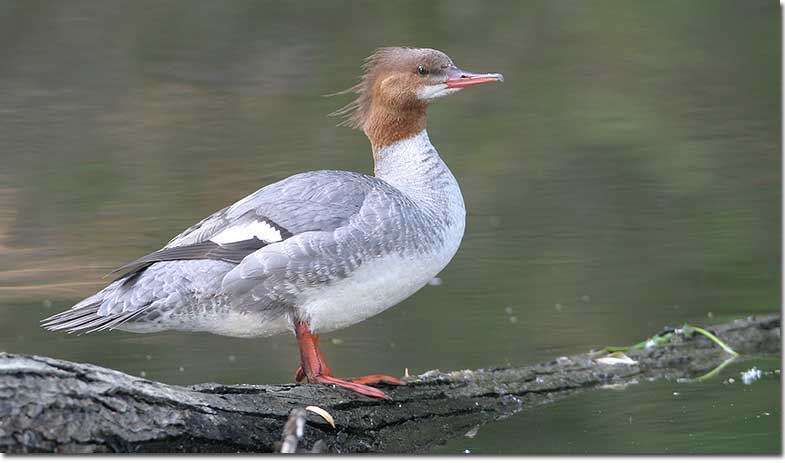
Common Merganser in eclipse plumage
This related species is often confused with the Red-breasted Merganser, especially females.
However, with a good look, we can see that the female Common Merganser has a brown head that does not blend in with her gray neck. She also has a slightly larger bill, is heftier, and has more white on her throat.
The male Common Merganser differs from the Red-breasted by its all white underparts and heftier appearance.
Mallard
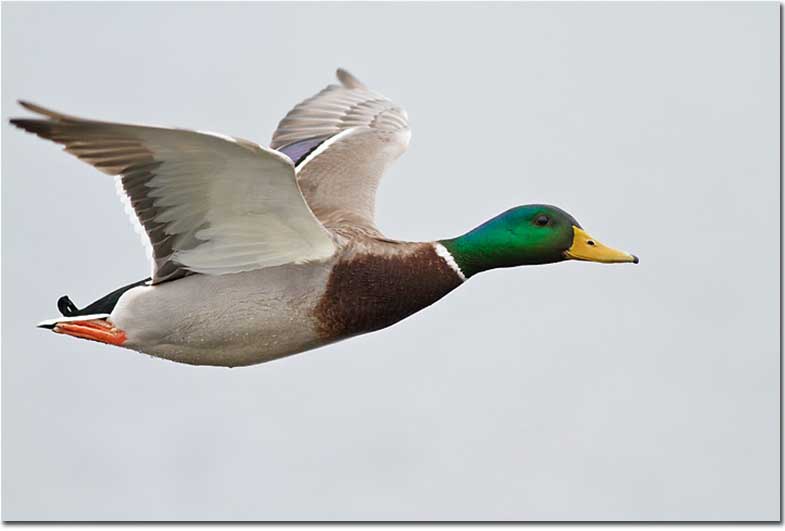
The male of this familiar duck also has a dark green head and chestnut on its breast, but it differs from the Red-breasted in many other ways.
The Mallard has a classic, duck-shaped beak, paler flanks, and does not have big white patches in its wings.
Hooded Merganser
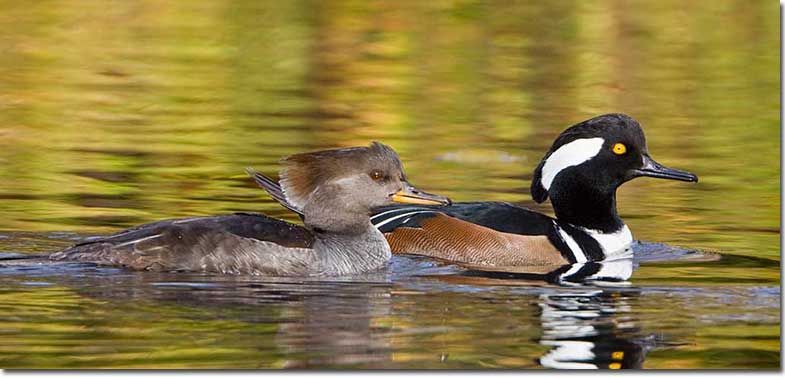
Hooded Merganser pair
This small duck has a slender shape and beak kind of like a Red-breasted Merganser. Its plumage, though, is very different.
The female Hooded Merganser looks a bit like the female Red-breasted but is darker overall and only has a little bit of white in her wings. Male Hooded Mergansers have black and white heads, dark orange flanks, and other differences.
Frequently Asked Questions
Are Red-breasted Merganser rare?
No, Red-breasted Merganser are not rare. During migration and winter, these ducks are common on the Great lakes and many coastal areas.
Where does the Red-breasted Merganser live?
The Red-breasted Merganser lives on cold rivers and lakes of the far north. It also spends the winter on large lakes and coastal waters in many parts of Canada and much of the USA.
What is the difference between a Red-breasted Merganser and a Common Merganser?
The difference between a Red-breasted Merganser and a Common Merganser is that the Red-breasted Merganser has a wispy, double crest and thinner beak.
The male Red-breasted Merganser also has dark brown on its breast, and gray flanks. The female Red-breasted Merganser has a paler brown head with less white on her throat.

